
Viminaria juncea is the single species in the genus Viminaria endemic to Australia. The genus is in the pea family Fabaceae. It is colloquially known as native broom after its resemblance to the related European broom plants. The Noongar peoples know the plant as koweda.
Stinkwood, german Stinkholz, french Bois Puant, is the common name for a number of trees or shrubs which have wood or plant parts with an unpleasant odour, including:

Hakea laurina is shrub or small tree commonly known as kodjet or pin-cushion hakea and is endemic to Western Australia. The Noongar name for the plant is kodjet or kojet. It has red and cream conspicuous globular flowers and lance shaped leaves.

Banksia aurantia, commonly known as the orange dryandra, is a shrub that is endemic to Western Australia. It has underground stems, deeply divided leaves with 18 to 28 lobes on each sides, about eighty pale orange-pink flowers in each inflorescence, and egg-shaped follicles.
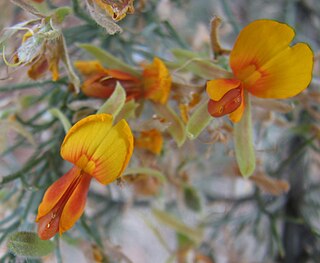
Jacksonia is a genus of about forty, mostly leafless broom-like shrubs or small trees in the flowering plant family Fabaceae. The genus is endemic to Australia and species occur in a range of habitats in all Australian states except South Australia.

Jacksonia furcellata, commonly known as grey stinkwood, is a species of leafless broom-like shrub or small tree in the family, Fabaceae, that occurs in the south west of Western Australia. One of the most common plants of the Swan Coastal Plain, it is an excellent colonizer of newly cleared land. It is often seen growing where soil has recently been disturbed, such as alongside new roads.

Jacksonia sericea, commonly known as waldjumi, is a species of low-spreading shrub or small tree that occurs in the south west of Western Australia. Found on the Swan Coastal Plain, it grows to 0.6m, has orange flowers from December to February and grows in calcareous and sandy soils. It has a Priority Four classification on the Department of Parks and Wildlife's Declared Rare and Priority Flora List.

Jacksonia scoparia, commonly known as dogwood, is a native species of a pea-flowered, greyish, leafless, broom-like shrub or small tree that occurs in the south east of Queensland, Australia and eastern New South Wales.
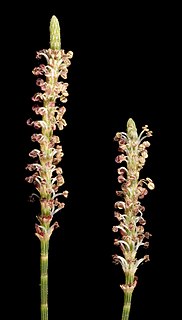
Casuarina obesa, commonly known as swamp she-oak or swamp oak, is a species of Casuarina that is closely related to C. glauca and C. cristata. The Noongar peoples know the plant as Goolee, Kweela, Kwerl and Quilinock.

Daviesia triflora is a shrub in the pea family, Fabaceae, endemic to South West Australia.
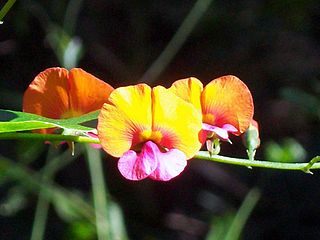
Chorizema cordatum, known as the heart-leaf flame pea or Australian flame pea, is a flowering plant of the pea family, endemic to gravelly or loamy soils in eucalyptus forests, in the moist south western parts of Western Australia. The Noongar peoples know the plant as kaly.

Candalides cyprotus, the cyprotus blue or copper pencil-blue, is a species of butterfly of the family Lycaenidae. It is found along the east coast of Australia, including South Australia, New South Wales, Western Australia and Victoria.

Xylomelum occidentale, commonly known as the western woody pear, is a tree species in the family Proteaceae. It is endemic to Western Australia.

Bossiaea aquifolium , commonly known as water bush, nedik or netic, is a species of flowering plant in the pea family Fabaceae and is endemic to Southwest Australia. It is a slender shrub or small tree with egg-shaped leaves arranged in opposite pairs and yellowish flowers arranged singly or in pairs on the ends of branchlets.
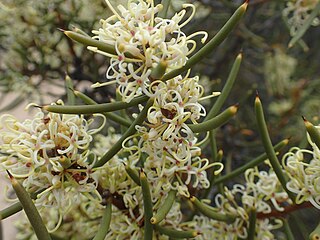
Hakea preissii, commonly known as the needle tree, needle bush and Christmas hakea, is a shrub or tree of the genus Hakea native to Western Australia. The Noongar name for the plant is Tanjinn.
Synaphea polymorpha, commonly known as Albany synaphea, is a species of small shrub in the flowering plant family Proteaceae. It is endemic to Western Australia. The Noongar peoples know the plant as bindak.

Jacksonia lehmannii is a species of leafless broom-like shrub or small tree in the family Fabaceae that is native to the south west of Western Australia. It was first described by Carl Meissner in 1844. It has no synonyms.
Jacksonia horrida is a species of leguminous plant occurring in Southwest Australia on wetter sandy soil and coastal dune systems. It bears yellow and orange to red flowers and may be prostrate or erect to a height of 2.5 metres. The distribution range extends south of Perth, occurring in higher rainfall coastal regions until reaching the west of the Esperance Plains.

Daviesia hakeoides is a spiny shrub species in the family Fabaceae. It is endemic to Western Australia. It grows to from 0.2 to 1 metre high and has yellow/orang/red/brown pea flowers, produced between May and September in the species' native range. It grows in gravelly soils, sand and granite on stony hills, sandplains and flats.
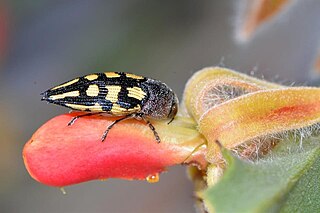
Jacksonia anthoclada is a plant in the Fabaceae family. It is endemic to Western Australia.
















